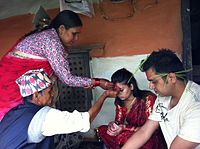Vijayadashami
Traditional Vijayadashami (Sanskrit: विजयादशमी, romanized: Vijayadaśamī), more commonly known as Dassahra in Hindi-Urdu,[a] and also known as Dashāhra or Dashain in Bhojpuri, Maithili and Nepali, is a major Hindu festival celebrated every year at the end of Durga Puja and Navarahtri.[1][7][8] Vijayadashami celebrations include processions to a river or ocean front that involve carrying clay statues of Durga,[13] Lakshmi, Saraswati, Ganesha, and Kartikeya, accompanied by music and chants, after which the images are immersed in the water for dissolution and farewell.Prior to this, Ravana performed severe penance for ten thousand years and received a boon from the creator-god Brahma that he could henceforth not be killed by gods, demons, or spirits.[27] The epic tells the story of the Pandava brothers who are known to have spent their thirteenth year of exile under concealed identity in Matsya, the kingdom of Virata.[31] It is celebrated across Northern India for Dussehra, but particularly in historically important Hindu cities of Ayodhya, Varanasi, Vrindavan, Almora, Satna and Madhubani.[31] The festival and dramatic enactment of the virtues versus vices filled story is organised by communities in hundreds of small villages and towns, attracting a mix of audiences from different social, gender and economic backgrounds.[33] Celebrations range from worshipping Durga, lighting up temples and major forts such as at Mysore, to displaying colourful figurines, known as a gombe habba.The Italian traveller Niccolò de' Conti described the festival's intensity and importance as a grandeur religious and martial event with royal support.The celebrations hosted athletic competitions, singing and dancing, fireworks, a pageantry military parade and charitable giving to the public.[34][35] Portuguese travellers like Domingo Paes and Fernao Nuniz who visited Vijayanagara Empire in the 16th century described the Dasara elephant procession and the Vajra Mushti Kalaga wrestling bouts.People of Karnataka exchange leaves of Shami tree as symbol of gold on 10th day evening marking the win over demon.Another significant and notable tradition of several Southern Indian regions has been the dedication of this festival to Saraswati, the Hindu goddess of knowledge, learning, music and arts.In Southern India, people maintain, clean and worship their instruments, tools of work and implements of their livelihood during this festival, remembering Goddess Saraswati and Durga.[34] In West Bengal Vijaya Dashami is observed as Bijoya Dashomi, immediately after Navami (the ninth and last day of Durga Puja).It is marked by processions in which idols are carried in carriages to a pond, river or ocean for a solemn good-bye to Goddess Durga, along with firecracker bursting, dance, drum beats, music and revelry.In Patna the capital of Bihar, people gather in historical Gandhi Maidan and a huge effigy of Ravan is burnt.





Vijayadasami (disambiguation)Dasara (disambiguation)HindusDurga PujaNavaratriPandalsRavanaHindu calendarHinduismMythologyOriginsHistoryIndus Valley CivilisationVedic HinduismDravidian folk religionŚramaṇaTribal religions in IndiaItihasa-PuranaEpic-Puranic royal genealogiesEpic-Puranic chronologySampradaya (Traditions)VaishnavismPancharatraShaivismKapalikaPashupataPratyabhijñaShaktismSmartismOther Sampradaya (Traditions)DeitiesAbsolute Reality / Unifying ForceBrahmanTrimurtiBrahmaVishnuTrideviSaraswatiLakshmiParvatiTridashaAdityasRudrasAshvinsMahadeviOther Vedic DeitiesAvatarDashavataraNavadurgaMahavidyaKartikeyaGaneshaHanumanShaktiDevatasVishvakarmaKuberaConceptsCosmologyTattvasSubtle elementsPanchikaranaGross elementsGuṇasPurushaPrakṛtiSupreme realityNirgunaSagunaSaccidānandaIshvaraGod in HinduismGod and genderPuruṣārtha (Meaning of life)DharmaMokshaĀśrama (Stages of life)BrahmacharyaGṛhasthaVānaprasthaSannyasaThree paths to liberationBhakti yogaJnana yogaKarma yogaLiberationParamātmanSaṃsāraĀtman (self)Anātman (non-self)Sūkṣma śarīra (subtle body)Antaḥkaraṇa (mental organs)Prajña (wisdom)Ānanda (happiness)Viveka (discernment)Vairagya (dispassion)Sama (equanimity)Uparati (self-settledness)Titiksha (forbearance)Shraddha (faith)Samadhana (concentration)Arishadvargas (six enemies)Ahamkara (attachment)NiyamaAhimsaAchouryaAparigrahaAkrodhaArjavaSantoshaSvādhyāyaShauchaMitaharaSources of dharmaEpistemologyPratyakṣa (perception)Upamāṇa (comparison, analogy)Śabda (word, testimony)WorshipĀrtīPrarthanaŚrautaTempleBhaktiBhajanaKīrtana